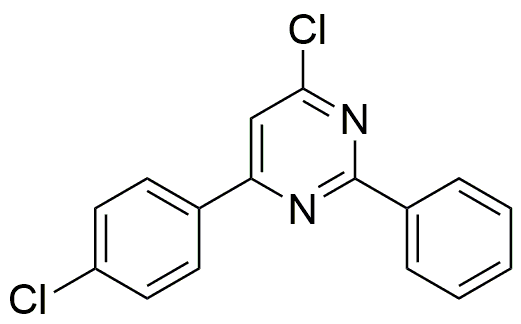4-Chloro-6-(4-chlorophenyl)-2-phenylpyrimidine is widely utilized in research focused on:
- Agricultural Chemistry: This compound serves as a key ingredient in developing herbicides, helping to control weed growth effectively while minimizing crop damage.
- Pharmaceutical Development: It is explored for its potential as an anti-cancer agent, with studies indicating its ability to inhibit specific cancer cell lines.
- Material Science: The compound is used in synthesizing advanced materials, including polymers that exhibit enhanced thermal stability and chemical resistance.
- Biochemical Research: Researchers utilize it to study enzyme inhibition, providing insights into metabolic pathways and potential therapeutic targets.
- Environmental Science: It plays a role in developing eco-friendly pesticides, aiming to reduce environmental impact while maintaining agricultural productivity.
Informations générales
Propriétés
Sécurité et réglementation
Applications
4-Chloro-6-(4-chlorophenyl)-2-phenylpyrimidine is widely utilized in research focused on:
- Agricultural Chemistry: This compound serves as a key ingredient in developing herbicides, helping to control weed growth effectively while minimizing crop damage.
- Pharmaceutical Development: It is explored for its potential as an anti-cancer agent, with studies indicating its ability to inhibit specific cancer cell lines.
- Material Science: The compound is used in synthesizing advanced materials, including polymers that exhibit enhanced thermal stability and chemical resistance.
- Biochemical Research: Researchers utilize it to study enzyme inhibition, providing insights into metabolic pathways and potential therapeutic targets.
- Environmental Science: It plays a role in developing eco-friendly pesticides, aiming to reduce environmental impact while maintaining agricultural productivity.
Documents
Fiches de données de sécurité (FDS)
La FDS fournit des informations de sécurité complètes sur la manipulation, le stockage et l’élimination du produit.
Spécifications du produit (PS)
Le PS fournit une description complète des propriétés du produit, notamment sa composition chimique, son état physique, sa pureté et les exigences de stockage. Il détaille également les plages de qualité acceptables et les applications prévues du produit.
Certificats d'analyse (COA)
Recherchez des certificats d'analyse (COA) en saisissant le numéro de lot du produit. Les numéros de lot et de lot se trouvent sur l'étiquette d'un produit, après les mots « Lot » ou « Lot de fabrication ».
Numéro de catalogue
Numéro de lot/série
Certificats d'origine (COO)
Ce certificat d'exploitation confirme le pays dans lequel le produit a été fabriqué, et détaille également les matériaux et composants utilisés et s'il est issu de sources naturelles, synthétiques ou autres sources spécifiques. Ce certificat peut être requis pour les douanes, le commerce et la conformité réglementaire.
Numéro de catalogue
Numéro de lot/série
Fiches de données de sécurité (FDS)
La FDS fournit des informations de sécurité complètes sur la manipulation, le stockage et l’élimination du produit.
DownloadSpécifications du produit (PS)
Le PS fournit une description complète des propriétés du produit, notamment sa composition chimique, son état physique, sa pureté et les exigences de stockage. Il détaille également les plages de qualité acceptables et les applications prévues du produit.
DownloadCertificats d'analyse (COA)
Recherchez des certificats d'analyse (COA) en saisissant le numéro de lot du produit. Les numéros de lot et de lot se trouvent sur l'étiquette d'un produit, après les mots « Lot » ou « Lot de fabrication ».
Numéro de catalogue
Numéro de lot/série
Certificats d'origine (COO)
Ce certificat d'exploitation confirme le pays dans lequel le produit a été fabriqué, et détaille également les matériaux et composants utilisés et s'il est issu de sources naturelles, synthétiques ou autres sources spécifiques. Ce certificat peut être requis pour les douanes, le commerce et la conformité réglementaire.


